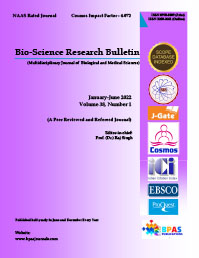Role of Parthenium hysterophorus in Human Health, Agriculture and Sustainability of Ecosystem
DOI:
https://doi.org/10.48165/bpas.2023.39.1.2%20Keywords:
Parthenium, Compost, Growth, Weed, Health and AgricultureAbstract
Parthenium is one of the most common weeds grow throughout the world due to its remarkable adaptability to a wide range of environmental conditions and soil types. This weed plant shows both harmful and beneficial effects to agriculture, ecosystem and human health. Its uncontrolled growth not only negatively impacted on the cultivation of agricultural plants but also causes asthma, bronchitis, dermatitis and hay fever etc. to both animals and humans. It is believed that uncontrolled natural growth of Parthenium may have an overall negative impact on the ecosystem. The Parthenium compost without any of its contaminated seeds is the rich sources of agriculture plant’s macro and micronutrients. Additionally various phytochemical constituents of parthenium have usefulness in agriculture as pesticides and therapeutic usefulness in the human society. The present compilation is an overview of the various aspects of parthenium growth both as natural contaminants during cultivation of agricultural plants as well as its controlled cultivation to benefit the agriculture, certain industries as well as overall human society.
References
Aneja, K.R., Dhawan, S.R. and Sharma, A.B. 1991. Deadly weed Parthenium hysterophorus L. and its distribution. Indian Journal of Weed Science. 23(3-4): 14-18.
Arshad, J., Sobiya, S., & Shazia, S. (2009). Comparison of Trifolium alexandrium L. and Parthenium hysterophorus L. green manures in rice-wheat cropping system. Philippine Agricultural Scientist, 92(1), 110-115.
Bailey L.H. (1960). Manual of cultivated plants, Macmillan, New York.
Biradar, D. P., Shivakumar, K. S., Prakash, S. S., & Pujar, B. T. (2006). Bionutrient potentiality of Parthenium hysterophorus and its utility as green manure in rice ecosystem. Karnataka Journal of Agricultural Sciences, 19(2), 256.
Channappagoudar, B. B. Biradar, N. R. Patil, J.B. and Gasimani, C.A.A. (2007) Utilization of weed biomassas an organic source in sorghum. Karnataka J. Agric. Sci. 20(2), 245- 248.
Dhawan, S.R. and Dhawan, P. (1996) Regeneration in Parthenium hysterophorous L. World Weeds, 2, 244-249.
Dhileepan K (2007) Biological control of Parthenium (Parthenium Hysterophorus) in Australian rangeland translates to improved grass production. Weed Sci, 55, 497–501.
Dominguez, X.A. and A. Sierra. (1970) Isolation of a new diterpene alcohol and parthenin from Parthenium hysterophorus. Plant Medica 18, 275-277.
Evans, H.C., (1997) Parthenium hysterophorus: a review of its weed status and the possibilities for biological control. Biocontrol News and Information. 18(3), 89-98.
Ghosh, S., Haldar, S., Shubhaneel, N., Ganguly, A., and Chatterjee, P.K, (2012) Kinetic study of the acid hydrolysis of Partheniumhysterophorus L. for xylose yield in the production of lignocellulosic ethanol. IOSR Journal of Pharmacy and Biological Sciences. 3(3), 35-41.
Goldsworthy, D. (2005). Parthenium weed and health. Technical report, The University of Central Queensland, Rockhampton, Australia. 281, 114525.
Gunaseelan, V. N. (1987). Parthenium as an additive with cattle manure in biogas production. Biological wastes, 21(3), 195-202.
Khan, M.S. and Ahmad, S. (2009) Pharmacognostical, phytochemical, biological and tissue culture studies on Parthenium hysterophorus Linn: a review. Internet Journal of Alternative Medicine. 6(2), 1-5.
Kishor P, Ghosh AK, Singh S, Maury BR (2010) Potential use of parthenium (Parthenium hysterophorus L.) in agriculture. Asian J Agric Res, 4, 220–225
Kumar, M., Kumar, R., & Singh, R. (2022). Parthenium a Noxious Weed: A Review on the Allelopathic Impact on Crop Plants and Their Management. Bio Science Research Bulletin, 38(2), 106-112.
Kumar, S. (2009). Biological control of Parthenium in India: status and
prospects. Indian Journal of Weed Science, 41(1-2), 1-18.
Lalita, K. A. (2018). Review on a weed Parthenium hysterophorus (L.). Int J Curr Res Rev, 10, 23.
Morton, J.F. (1981). The puzzling whitetop. Parthenium hysterophorus: Noxious weed, health hazard, folk-remedy, flea repellent. Unpublished report, Univ. of Miami, Florida.
Navie, S. C., McFayden, R. E., Panetta, F. D., and Adkins, S. W., (1996), “The biology of Australian weeds 27.Parthenium hysterophorus L, Plant Protection Quarterly. 11,
–88.
Pandey, D.K. (2009) Allelochemicals in Parthenium in response to biological activity and the environment. Indian Journal of WeedScience, 41(3-4), 111–123.
Patel, S. (2011). Harmful and beneficial aspects of Parthenium hysterophorus: an update. 3 Biotech, 1(1), 1-9.
Picman, J., & Picman, A. K. (1984). Autotoxicity in Parthenium hysterophorus and its possible role in control of germination. Biochemical Systematics and Ecology, 12(3), 287-292.
Rauf, A., Khan, I. A., Alnasser, S. M., Shah, S. U. A., & Rahman, M. (2022). Phytochemical analysis and in vitro and in vivo pharmacological evaluation of parthenium hysterophorus linn. Evidence Based Complementary and Alternative Medicine, 2022.
Roy D.P. and Shaik, M.M. (2013) Toxicology, phytochemistry, bioactive compounds and pharmacology of Parthenium hysterophorus,” Journal of Medicinal Plants Studies. 1(3): 126– 141.
Rao, R.S. (1956). Parthenium: A new record for India. J. Bombay Nat. Hist. Soc. 54, 218- 220.
Sethi, V. K., Koul, S. K., Taneja, S. C., & Dhar, K. L. (1987). Minor sesquiterpenes of flowers of Parthenium hysterophorus. Phytochemistry, 26(12), 3359- 3361.
Sharma, G.L. and Bhutani. K.K. (1988). Plant Based Antiamoebic Drugs; Part II. Amoebicidal Activity of Parthenin Isolated from Parthenium hysterophorus. Planta Med 54(2).
